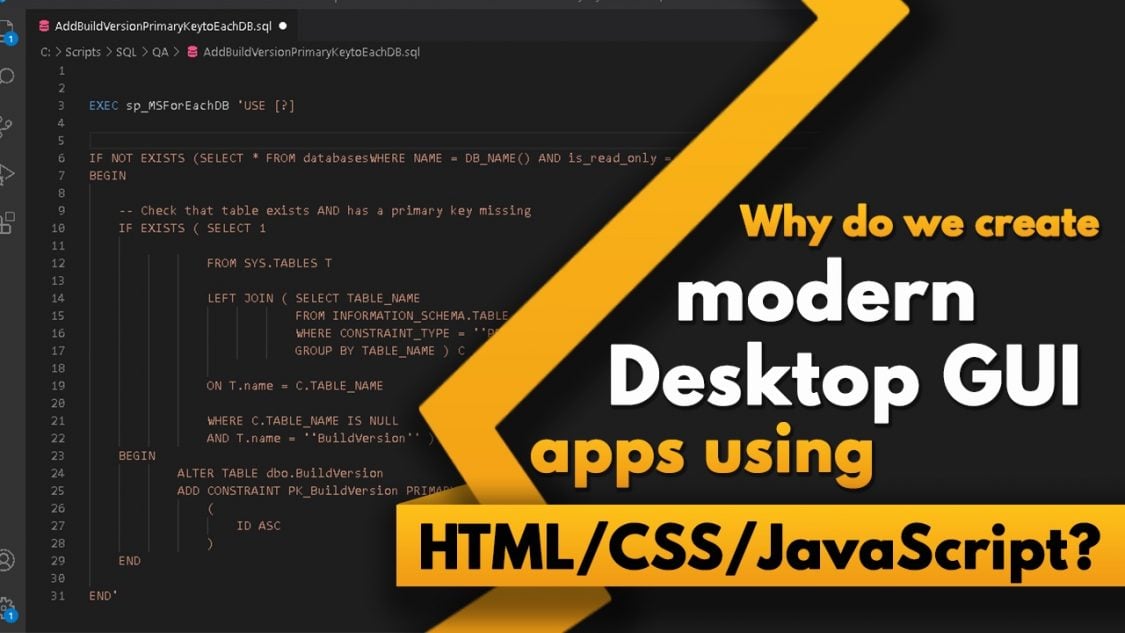This was a post on Quora and I thought I have more to say than I can write in a reply, so here goes, a blog article instead!
I have been involved with software development for nearly 30 years now, I have done front end and back-end stuff, I am responsible for the overall architecture and product strategy of a very large-scale application which spans front and back end. C++ is my background and as you might imagine by now, after 30 years I have an opinion here.
Let’s start with the obvious, there has been a meteoric rise of developing front end UI’s using HTML/CSS, this is not a fad, it’s a real thing, and its everything from desktop apps like Slack, Twitter, Facebook and many others, to mobile apps on Android and iOS, game UI’s, business applications, consumer applications, the list is basically endless. Even tools that developers use to create such UIs are themselves written in HTML/CSS and deployed using things like Electron. Visual Studio Code, Atom and many other dev tools fall into this category.
If you take a tool like Visual Studio Code, this is essentially a browser (Chromium), an embedded Node.js server with the HTML/CSS files all compiled into a deployable desktop binary. Because it is written in HTML/CSS targeting a browser, and because that browser (or variations of the same) generally target all notable platforms (Windows, Mac, Linux, Android iOS etc), then your desktop apps written this way are pretty much 100% cross-platform too for free. What is not to like…
In answer to the opening question, it really has bugger all to do with speed, in fact for UI stuff in particular, JavaScript in a browser will outperform your average native .NET developed UI of comparable complexity – by a very long way simply because the browser implementations are so highly optimised over a long an sustained periods of time (the notable exception to that claim being IE of course).
The problem with developing UI’s using HTML/CSS is that it is complicated, really complicated to do well. The root of the problem here is, browsers, and the HTML/CSS specification was never conceived as a desktop UI tool, it’s just demand for this has driven the browsers to evolve that way.
The browser standards have recognised this, and have made good headway in having different modes (known as display modes) which are optimised for different layout types, the classical natural document layout (Normal Flow) is what HTML was designed to do, but through continued evolution things like flex and grid have started to pave the way for far better separation of concerns between layout and design and facilitate layout schemes that are far more suited to modern desktop app style layouts.
A perennial problem with desktop style UI’s in a browser has been the issue of content height, this is because of the way HTML rendering/layout works for Natural Flow, and developers, because they can, have found many work-arounds for this using JavaScript to sort of fudge the layouts, but this leads to poor quality, inflexible and unmaintainable code – and a lot of it too. Then, to make things easier, dev teams will buy into a framework, like Angular JS, Vue.JS and those sorts of things, they are impressive and helpful, but they are even worse when it comes to obsolesce, for example build your application in Angular 1.x and the only realistic way of moving to Angular 2.x is to rewrite (at least substantially) your current codebase. Not because any framework is bad, they are all very good, but its because the browser and the thinking changes more quickly than most commercial application projects can accommodate.
And this leads to the next big problem, the now large and “expensive to create codebases” are locked into the design/implementation approach of the day, so even though the browsers have moved on significantly and the newer versions of the frameworks have much better things that would help, most codebases are essentially stuck at a point in time, and the only way out is a re-write completely – and for any significant commercial product that is simply not going to be an option – it is just too complicated to bring your customers on that journey.
That leaves evolution, that is taking advantage of new browser features as you add new stuff, and that works, but you very quickly end up with code that “no one wants to touch”. This is painful, expensive and is basically unavoidable, because today at least, any initiative to modernise and get back on track will take longer to do than it will take for the browser to evolve again.
Going back to native desktop apps then, perhaps that is a better long-term investment. Ten years ago, I would have agreed with that sentiment, after all, when it comes to desktops there are really only two players, Microsoft Windows and Apple OSX, so why not just target those, ideally with some shared code, and be done with it.
Just for completeness I should mention Linux, it is the best computing platform to happen to the world and should be admired in every way – except one! the desktop/UI sucks, its awful in almost every way, you are essentially targeting X11 which was developed in the 70’s and it shows. It works and it brings a couple of quirky features to the table which are quite nice, but, in essence, if you love Linux, just forget targeting GUI desktop stuff, you need a graphics screen, a browser (for a real UI) and a terminal window – that’s it… there is the Wayland stuff but its far too early, it’s also disjointed, barley supported and is grappling with compatibility with legacy stuff…
Ok so back to Windows and OSX. I am probably more scathing here than I ought to be, but it is easy to be this way to be honest. Bottom line is this, Microsoft want desktop supremacy, so they have, over a sustained period of time, deployed an “enterprise lock-in” strategy. Underpinning their stronghold with Visual Basic in the “enterprise in-house dev” arena back in the day, they embarked on their .NET journey. The .NET technology itself is not half bad, but the real tragedy is the way they simply closed off the desktop UI developer community to all but their own .NET developer tech stack community, ensuring that every new OS/Shell feature added to Windows, were only materially exposed to developers through their proprietary .NET stack, so if you were working in Win32 (the API of the day at the time) or if you want to write cross-platform desktop apps, you were basically plain out of luck. Microsoft played marketing lip-service of course, they supported multiple programming languages, but they favoured and ultimately championed C# and that was essentially your lock-in, you want to make a slick, modern Windows desktop application, you can, but it’s a closed shop, you need C#/.NET and of course for a long time, for native Windows, that’s still largely true, even today in 2022.
I have experience with a largish scale .NET application, and it is a horrible thing to maintain, its slow, clunky, buggy as hell, and many components are now out of date, and we are locked into that point in time – that’s what happens, so really no better than the situation with HTML/JavaScript at all, in fact I would argue it’s a lot worse in the longer term.
What about OSX, absolutely great desktop UI, the best in the business IMHO from a user perspective (at least until very recently), so you can choose to be an “elite” and just build desktop apps for OSX right? What you find here though, is it is even worse than Microsoft – if that’s even possible, Apple built their UI on a framework that is essentially only accessible (for all practical purposes) via their own Objective-C language, and my goodness, what a terrible think that is. If Apple ever do wonder why at the height of their iMac/Intel popularity, their desktop never took more than a few percent of the global market, ask the developers who looked at their development environment and said, “no thanks”, I would put that down entirely to their very own version of an “elite developer tie-in strategy”, looking at Microsoft you would think no one could do worse than them in this regard – Apple did… and continue to do so today. For OSX, there is a more modern choice today, it is called Swift, it is another proprietary language developed by Apple and is following Microsoft’s blueprint of .NET. Swift in use, is really just like a more friendly version of ObjectiveC, that dispenses with C-style pointers and looks a bit more like a JavaScript/C# mash-up, I expect the technology behind it is good, but it’s too proprietary, and no one apart from Apple die-hards are interested, or cares to the best I can tell. Most desktop applications that target the Mac today tend to be HTML/CSS/JavaScript in Electron type apps for that very reason.
Developing desktop apps in 2022 is essentially an HTML/CSS/JavaScript endeavour, and at the rate the open browser standards are evolving, I find it difficult to see why this is going to change any time soon, the performance of a well written UI in a modern browser out-performs a native desktop application in every category of sped, usability and presentation for most usual use cases. Menu’s and forms *could* have a slight advantage in native apps over their browser counterparts, but there is not much in it at all and browsers are getting much better in this regard. But for native desktop applications, when you start to want to use mix-ins of rich media like sound, video, 2D/3D graphics and suddenly the native UIs of the day, even from Microsoft and Apple are no match at all for what a modern browser has to offer.
When it comes to developing modern UI’s in HTML/CSS I am both excited for the future and frustrated by the sheer complexity involved today. The complexity itself is not a problem, but the codebases it ultimately leads to is a big and very expensive long term problem. If I could wave a magic wand, I would create an open working group, with the influence of the W3C behind me, to create a mandatory web standard for browsers that defines both a subset (to simplify and create an *appropriate* desktop security model) and extension of CSS/HTML that is specifically optimised for marking up and implementing desktop applications, and have that all built into modern browsers as standard. The goal would be to simplify the creation of desktop application UI’s and open the web platform up to people that currently won’t go near HTML/CSS with a bargepole. This would move personal computing on a long way IMHO.
If this was done well I would expect to see a serious migration of desktop development over to browser development, much faster than we are seeing now, and tooling/runtimes/sandboxes like Electron and others, would be the new kids on the block.
Even better, would be to see Microsoft, Apple (desktop and mobile), Android and Linux adopt such a standard and get behind it, moving away from the proprietary tie-in developer environments they currently impose on their users. This could be a serious desktop strategy for Linux too – and that right there is probably the truth of why this last part would never happen. Could you imagine a future where desktop applications were built like this, and in every sense of the word, “portable between operating systems” with the experience being identical on all platforms…. I expect Microsoft and Apple would see this as a very bad idea… that is, for as long as selling their operating system/hardware is an integral part of their go-to-market strategy.
What do you think?


